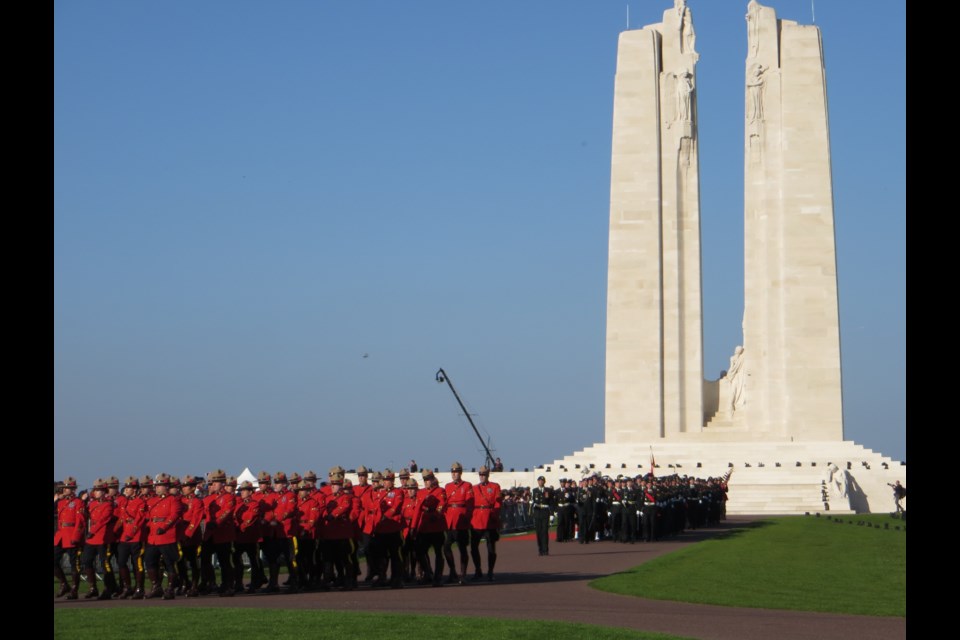The haunting melody of Amazing Grace floated over the noise at Vimy Ridge in France, performed on a flute with connections to a battle described as “the birth of a nation.”
More than 25,000 Canadians gathered around the Vimy monument on April 9, 2017, to commemorate the centennial of the First World War event and pay homage to the 100,000 Canadian boys who participated in the April 9 to 12, 1917 battle.
The Battle of Vimy Ridge cost Canadians 3,598 dead and 7,004 wounded. The battle was notable for being the first time all four divisions fought together.
As Brig. Gen. Alexander Ross — after whom the Yorkton legion is named — said in 1967, about the 1917 battle, “It was Canada from the Atlantic to the Pacific on parade. I thought then … that in those few minutes, I witnessed the birth of a nation.”
The names of 11,285 Canadian soldiers are listed on the monument, remembering those men who died during the war and have no known grave.
Moose Jaw connections
After some research, it was determined that 39 soldiers who died at Vimy Ridge were either from Moose Jaw and area or enlisted in Moose Jaw. The soldiers include Pte. Robert Halls Atkinson, Pte. Robert Frederick Bourns, Pte. Charles Franklin Clark, Cpl. Harry Foster (Moose Jaw-born), Company Sgt. Maj. Lawrence Leggott King, Pte. Neil McQueen, Pte. William Johnstone Milne, V.C., Pte. Leland Stanford Ross, Pvt. Arthur Ernest Thomson (Moose Jaw-born), Pte. Maryon Seldon Caskey, Pte. Douglas McEachern, Pte. Peter McKenzie, Pte. James Brydon, Pte. William Cornelius Kent, and Pte. William Roy Hawes.
Also, there were Pte. Robert Percy Kissick, Pte. George Thomas Bird, Pte. Robert Younger, Sgt. T.A.H. McCroden, Lance Cpl. Robert Henry Lee Grant, Pte. Harry Edward Camp, Pte. John Apps, Pte. Walter Cooley, Pte. Albert Edward Harvey, Pte. Arthur Robert Hopkins, Pte. David Laporte, Pte. Walter Arthur Parker, Pte. John McPhail, Pte. Albert John McRorie, Pte. Edward J. Nelson, Pte. Arthur Cecil Young, Pte. A. Philipps, Pte. William Henry Pollard, Pte. Albert Edwin Ramsey, Pte. Wilfred Whitford, Pte. Arthur Gamble, Pte. W. Thompson, Pte. Guy Pearse Stephenson, and Pte. A.B. Gamble.
The Vimy Flute
Calgarian Ryan Mullens, 35, put his lips to the wooden flute and began playing Amazing Grace, as passersby stopped to listen or take pictures.
The flute — one of three — was made from oak trees connected to Vimy.
A century ago, after the intense fighting subsided, Lt. Leslie Miller scooped up some acorns he found under a half-buried oak tree. Almost every other tree had been destroyed.
He sent the acorns home to Scarborough, Ont., with instructions to plant the seeds. During the next century, nine acorns grew into tall oak trees.
In September 2016, a Toronto-area flute maker took the trees’ dead branches and crafted them into playable instruments.
“The story of the wood is the special thing,” Mullens told this reporter after the Vimy Ridge event.
As Mullens spoke about the flutes publicly, the Vimy Foundation invited him to play the instruments at Vimy before the event began. For almost three hours, Mullens shared the story and performed Amazing Grace three times.
“I’ll be honest, it was amazing and challenging,” Mullens said.
While on a two-week pilgrimage of remembrance to Europe — a trip this passionate history buff also took — Mullens played the flute on former battlefields and in Canadian cemeteries to honour the soldiers.
“It’s a sacred instrument,” he remarked.
Performing at Vimy was challenging since Mullens couldn’t get near the monument due to tight security, couldn’t find a quiet space in which to play, and believed the flute wasn’t meant to entertain people.
The centennial event turned into a spectacle.
“The special moment was laying (all three flutes) on the ground and playing (one),” Mullens said. “That is the promise I made to the flutes’ creator. They would be back where they originally came.”
The Vimy monument is a majestic creation mourning Canada’s war dead. Everyone should make a pilgrimage to the site at some point.
The rock star
Joining Mullens and this intrepid reporter on the European pilgrimage was William (Willy) McGregor, 96, a Second World War veteran who slogged ashore at Juno Beach three days after D-Day in 1944.
McGregor and an Ontario veteran were given the rock star treatment during the Vimy Ridge commemoration, sitting in prime seats under a tent in front of the monument and receiving attention from students, passersby and the media.
“It was a little overdone,” he chuckled afterward. “I’m not used to publicity. I’m just a common guy … It is an honour (to be here).”
McGregor was a front line medic with the 11th Field Ambulance during the Second World War.
Honouring the Vimy Ridge battle was important since it was near the end of the Great War and many boys gave their lives in the process, said McGregor. Canadians should celebrate — or pay their respects — to this particular battle.
McGregor, from Bonnyville, Alta., never knew anyone who fought at Vimy Ridge while growing up, but met many veterans from The War to End All Wars.
“We haven’t learned a darned thing,” said McGregor about war. “There is still conflict throughout the world. It’s difficult because there are still people being killed every day.”
The Vimy flute factors into McGregor’s story too. His brother, John, was killed on Feb. 27, 1945, and is buried in Groesbeek Canadian War Cemetery in Netherlands. Our historical tour group stopped at the cemetery, where Mullens — with Willy beside him — played Amazing Grace in front of John’s headstone. Many people were moved to tears over Mullens’ kind gesture for McGregor’s brother.
Lest we forget.
This story is one of many featured in our Remembrance Day supplement. You can read the issue online or pick up a copy at our office (32 Manitoba St. West).




